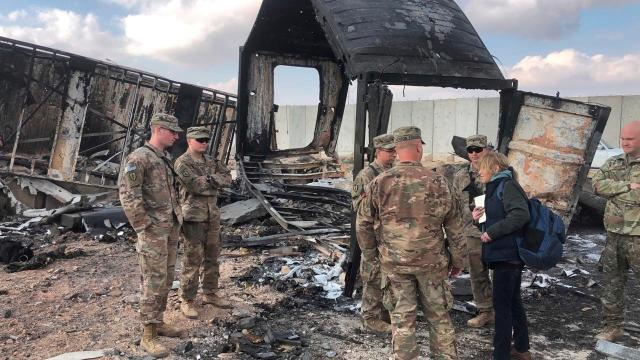The White House initially minimised the consequences of retaliatory Iranian missile strikes that hit joint U.S.-Iraqi bases in Iraq on January 8 in response to Donald Trump’s reckless decision to assassinate a senior Iranian official. But last week, news broke that at least 11 U.S. troops had actually been treated for traumatic brain injury (TBI). Pentagon spokesperson Jonathan Hoffman told reporters at a press conference on Friday that the number is now up to 34.
Trump and Secretary of Defence Mark Esper had tried to downplay the injuries earlier this week, with Trump claiming those treated just had “headaches” that weren’t “very serious,” and Esper saying it was “mostly outpatient stuff.” Now the number of soldiers diagnosed with TBI has more than tripled from earlier estimates—and at least 17 of those troops are still being observed at locations in the U.S. and Germany, according to ABC News. Per NPR, Hoffman said that eight of those 17 troops had arrived back in the U.S. and would be treated on an outpatient basis, while the nine in Germany remain at Landstuhl Regional Medical Centre.
It’s clear that the Trump administration has gone above and beyond in its efforts to portray the Iranian counter-attack as a blip on the radar, but the delay in notifying the public about the injuries is likely in part due to the difficulty of diagnosing TBI. Medical experts told Gizmodo that while the continued holding of the soldiers for over two weeks could indicate their injuries aren’t minor, there are numerous reasons it can take a long time to identify brain trauma and determine the extent of any damage.
Dr. Robert Stevens, an associate professor of anaesthesiology and critical care medicine at the Johns Hopkins University School of Medicine who researches TBI and neurological care, told Gizmodo via phone, “There is no doubt exposure to a blast can cause significant brain injuries.”
Blast TBIs are “a specific type of TBI that’s caused by the physical forces exerted on the brain by the energy generated” in an explosion, Stevens added. That wave of energy “can cross the skull and cause significant damage to the brain independently of any sort of impact. … We know from clinical studies that blast injuries are serious, they can have long-lasting effects and can lead to significant neurological disability. We also know from imaging that blasts can lead to extensive disseminated damage” that differs significantly from patient to patient.
Stevens added that it can take time to identify TBI from explosions, as “the symptoms can be non-specific and overlap significantly with other issues like post-traumatic stress disorder.” After the initial phase immediately following the blast in which individuals may lose consciousness or feel dazed and confused, he said, people with TBI may feel as though they have returned to normal. But in the following days to weeks, they could experience delayed symptoms like headaches, trouble concentrating or speaking, impulse control, emotional lability, and anxiety. Service members may also be reluctant to report and/or minimise those symptoms for worry that it would be perceived as weakness by others or to avoid leaving their units, Stevens added.
Stevens said that he didn’t know the details of why the soldiers are being held for further observation or monitoring but that it “would not be typical to hospitalise someone after a mild TBI or a concussion.”
“It depends what observation means,” NYU Langone Concussion Centre neurologist and co-director Dr. Daniel Torres told Gizmodo via email. “Patients remain under a physician’s care until they are doing normal activities without symptoms. In general, even in sports concussion a 4 week recovery period is firmly within the normal expected time frame for recovery. With blast injuries a longer recovery period would be common.”
Torres wrote that it could take time for early symptoms to become apparent and that they often change over time: “For example, while initially there might only be imbalance, headaches might start after a few days, and emotional symptoms might not be apparent early.” He added that it is common for patients to remain under his care for TBIs for anywhere from two months to two years, and in some cases longer.
“After blast related TBI, in one study, the average time from injury to return to full duty was about one week,” Dr. Wendy Ziai, an associate professor of neurology, anaesthesiology, and critical care medicine at Johns Hopkins wrote to Gizmodo. “After 2 weeks, over 80% of the population had returned to full duty. However, we do not know the reason for observation, or the level of care required by these longer term patients.”
“Obviously the trajectory of recovery may vary for patients who are not able to return to full duty quickly or required higher levels of care, and some symptoms such as headache, visual and hearing deficits may last somewhat longer,” she added.
In other words, Trump was just making stuff up that sounded good to him at the time, as he’s done in the past while ranting about how pro sports players don’t need to be yanked from play due to concussions.
Hoffman told journalists at the press conference that Esper had ordered a review of how the military tracks and reports injuries to service members, according to ABC.
“Sometimes the administrative reporting of an injury is different than the medical reporting,” Hoffman told reporters. “We need to get that clarified, we need to get a better handle on it.”
